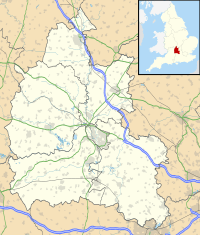Ascott Earl Castle facts for kids
Quick facts for kids Ascott Earl Castle |
|
|---|---|
| Ascott Earl, Oxfordshire, England | |

Motte and bailey remains of the castle in the background
|
|
| Coordinates | 51°51′48″N 1°34′12″W / 51.8634°N 1.5701°W |
| Site information | |
| Condition | Earthworks only |
Ascott Earl Castle was a historic castle located in the small village of Ascott Earl, found in Oxfordshire, England. It was built a long time ago, designed in a special way called a "motte-and-bailey" castle. Today, you can still see parts of where it once stood.
Contents
What Was Ascott Earl Castle?
Ascott Earl Castle was a type of castle built during the Middle Ages. It was constructed in the village of Ascott Earl. This castle was designed using a popular style known as a motte-and-bailey.
How Was a Motte-and-Bailey Castle Built?
A motte-and-bailey castle had two main parts:
- A motte was a large, raised earth mound. The main tower or keep would sit on top of this mound. This made it hard for enemies to attack.
- A bailey was a courtyard area. It was usually surrounded by a wooden fence or wall and a ditch. This area held buildings like stables, kitchens, and homes for soldiers.
Where Was Ascott Earl Castle Located?
This castle was built in a very interesting spot. It was placed on top of even older defenses. These older structures were from the Iron Age, a time thousands of years ago. This shows that people have used this location for protection for a very long time.
The castle was also very close to another castle. This was Ascot d'Oilly Castle, which was on a nearby piece of land. It was at the other end of the same village.
What Does Ascott Earl Castle Look Like Today?
Today, you won't see a tall castle tower at Ascott Earl. Instead, you can see the remains of the earthworks. These are the parts of the castle made from earth. The motte, or mound, is about 56 meters (184 feet) wide. It stands about 3.5 meters (11.5 feet) high.
The bailey, or courtyard area, is shaped like a crescent moon. It measures about 70 meters (230 feet) by 30 meters (98 feet) wide. These earthworks are now protected as a "scheduled monument." This means they are an important historical site. They are kept safe so people can learn about them in the future.


